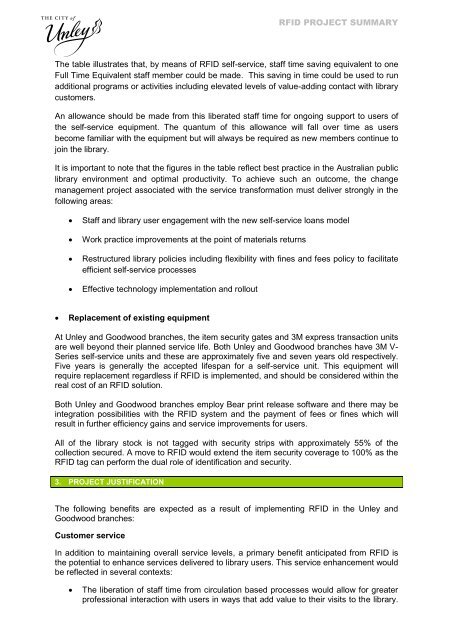RFID_Project_Summary
Create successful ePaper yourself
Turn your PDF publications into a flip-book with our unique Google optimized e-Paper software.
<strong>RFID</strong> PROJECT SUMMARY<br />
The table illustrates that, by means of <strong>RFID</strong> self-service, staff time saving equivalent to one<br />
Full Time Equivalent staff member could be made. This saving in time could be used to run<br />
additional programs or activities including elevated levels of value-adding contact with library<br />
customers.<br />
An allowance should be made from this liberated staff time for ongoing support to users of<br />
the self-service equipment. The quantum of this allowance will fall over time as users<br />
become familiar with the equipment but will always be required as new members continue to<br />
join the library.<br />
It is important to note that the figures in the table reflect best practice in the Australian public<br />
library environment and optimal productivity. To achieve such an outcome, the change<br />
management project associated with the service transformation must deliver strongly in the<br />
following areas:<br />
<br />
<br />
<br />
<br />
Staff and library user engagement with the new self-service loans model<br />
Work practice improvements at the point of materials returns<br />
Restructured library policies including flexibility with fines and fees policy to facilitate<br />
efficient self-service processes<br />
Effective technology implementation and rollout<br />
<br />
Replacement of existing equipment<br />
At Unley and Goodwood branches, the item security gates and 3M express transaction units<br />
are well beyond their planned service life. Both Unley and Goodwood branches have 3M V-<br />
Series self-service units and these are approximately five and seven years old respectively.<br />
Five years is generally the accepted lifespan for a self-service unit. This equipment will<br />
require replacement regardless if <strong>RFID</strong> is implemented, and should be considered within the<br />
real cost of an <strong>RFID</strong> solution.<br />
Both Unley and Goodwood branches employ Bear print release software and there may be<br />
integration possibilities with the <strong>RFID</strong> system and the payment of fees or fines which will<br />
result in further efficiency gains and service improvements for users.<br />
All of the library stock is not tagged with security strips with approximately 55% of the<br />
collection secured. A move to <strong>RFID</strong> would extend the item security coverage to 100% as the<br />
<strong>RFID</strong> tag can perform the dual role of identification and security.<br />
3. PROJECT JUSTIFICATION<br />
The following benefits are expected as a result of implementing <strong>RFID</strong> in the Unley and<br />
Goodwood branches:<br />
Customer service<br />
In addition to maintaining overall service levels, a primary benefit anticipated from <strong>RFID</strong> is<br />
the potential to enhance services delivered to library users. This service enhancement would<br />
be reflected in several contexts:<br />
<br />
The liberation of staff time from circulation based processes would allow for greater<br />
professional interaction with users in ways that add value to their visits to the library.



